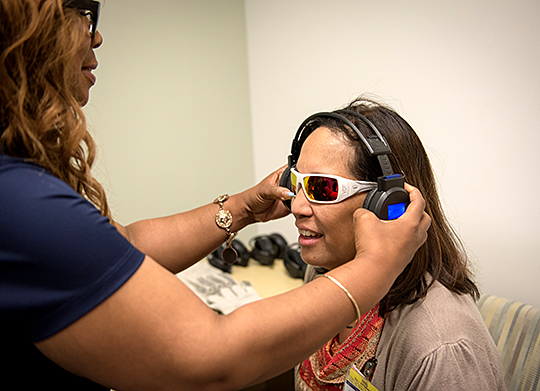Unfamiliar surroundings, confusing instructions and dulled senses are a recipe for frustration and anxiety.
They’re also a window into the life of someone who is living with dementia.

Participants in the Virtual Dementia Tour put on vision-limiting glasses and other items that dull their senses to recreate the confusion and frustration dementia patients experience in their daily lives.
“It’s a good opportunity to have an empathetic lived experience,” said Dr. Alexia Metz, UT associate professor of occupational therapy. “We hope this gives our students an anchor point to think back to in a moment where a client is having a challenge or a frustration, and to think creatively about how to teach caregivers and people in other professions to have some of that empathy.”
Developed by P.K. Beville and donated to the nonprofit group Second Wind Dreams, the Virtual Dementia Tour immerses students — if only for a few minutes — in the experience of struggling to do things that wouldn’t normally take a second thought.
“It’s going to be a very eye-opening experience, I promise you,” said Kirsten Pickle, executive director of West Park Place. “When you leave here today, we want you to have a little better understanding of the prevalence of dementia, the impact of dementia on caregivers, and what a person with dementia may be experiencing.”
To ensure the experience is as meaningful as possible, most of the specific methods are kept under wraps. Participants are outfitted with an array of gear that alters their senses and then asked to complete a list of everyday tasks alongside a partner.
For many of the students, even those who have been around or cared for those with dementia, the Virtual Dementia Tour was indeed eye-opening.
“It really demonstrated how much our experiences and abilities are shaped by our senses and knowledge of the environment around us. It was much more frustrating and anxiety-provoking not being able to complete simple things or locate objects than I had expected it to be,” said Emily Ottinger, a second-year occupational therapy doctoral student.
“It really helped me to view dementia as something more than just a memory issue, and to consider all of the other related barriers so that when I do work with individuals who have a dementia diagnosis, I can provide better and more holistic treatment.”
Occupational therapists often work directly with Alzheimer’s patients, but even those who don’t practice in geriatric care settings are likely to encounter individuals with dementia throughout their career as the number of dementia patients continues to grow.
The Alzheimer’s Association estimates 5.7 million Americans are living with the disease. As the Baby Boomers age, the association projects that number to increase to 14 million by 2050.
Because of that, Metz said it’s important to give students all the tools possible to ensure they’re both understanding caregivers and compassionate advocates.
“You fall short in teaching if you teach this kind of thing straight from a book. To feel that innate frustration coming from inside you rather than just seeing it from someone else gives them a much better understanding,” she said. “It prepares our students to be better occupational therapists.”